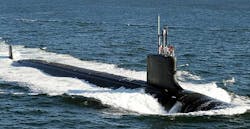Navy providing new photonics sensor masts to improve attack submarine stealth and survivability
Officials of the Naval Sea Systems Command in Washington on Friday announced an $111.8 million contract to L-3 KEO (formerly Kollmorgen Electro-Optical) to develop deployable prototypes of the Low Profile Photonics Mast (LPPM). With options the contract could be worth $157 million.
Photonics masts operate in place of the traditional submarine periscope aboard Navy Virginia-class attack submarines. The photonics mast uses a variety of electro-optical sensors, and does not penetrate the submarine hull like a traditional periscope does. Photonics mast sensors connect to the submarine by optical fiber.
The LPPM is a modular non hull-penetrating imaging sensor sited in a telescoping universal modular mast bay that provides submarines with improvements in stealth and survivability. Imagery from the LPPM is displayed on high-definition screens aboard the submarine.
Features include short-wave infrared (SWIR) and high-definition visual imaging, laser range finding, special stealth features, and an antenna suite with broad spectral coverage and direction finding. L-3 Communications acquired Kollmorgen Electro-Optical in 2012. SWIR sensors particularly are adept at penetrating fog, haze, and other obscurants.
The LPPM is a low-observable optical mast that reduces the submarine's risk of detection by enemy submarines and surface warships while the system is in use, while improving the submarine's sensor capability.
The contract to L-3 on Friday is for LPPM development, spare parts, and temporary alteration for installation costs for LPPMs onboard Virginia-class submarines in the Navy's Pacific Fleet.
Navy Chief of Naval Operations Adm. Jonathan Greenert, the Navy's top commander has asked for all Pacific Fleet Virginia-class submarines to be equipped with the LPPM and spare parts for the system to be made available beginning this year to support sensitive missions vital to national security, Navy officials say.
Related: Lockheed Martin to upgrade electro-optical imaging systems for Navy submarine fleet
LPPM prototypes initially were developed without the installation and spares necessary to support deployments and were intended only for integration and testing as part of local operations, Navy officials say. Greenert is trained as a submarine officer.
Production masts will not be available as fleet deployable assets until 2018, and the only way to provide the LPPM capability this year is to employ the LPPM prototypes on all deploying Virginia-class submarines.
On this contract L-3 KEO will receive $48.7 million up-front with the rest of the money to be allocated as contract options. The company will do the work in Northampton, Mass., and Newington, Va., and should be finished by December 2018.
For more information contact L-3 KEO online at www.l-3com.com/keo, or Naval Sea Systems Command at www.navsea.navy.mil.

